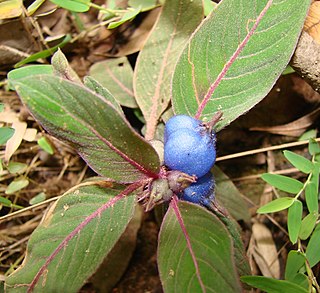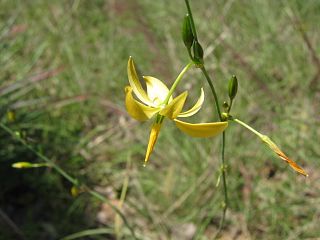
Chusquea is a genus of evergreen bamboos in the grass family. Most of them are native to mountain habitats in Latin America, from Mexico to southern Chile and Argentina.

Zamia is a genus of cycad of the family Zamiaceae, native to North America from the United States throughout the West Indies, Central America, and South America as far south as Bolivia. The genus is considered to be the most ecologically and morphologically diverse of the cycads, and is estimated to have originated about 68.3 million years ago.

Rauvolfia is a genus of evergreen trees and shrubs, commonly known as devil peppers, in the family Apocynaceae. The genus is named to honor Leonhard Rauwolf. The genus can mainly be found in tropical regions of Africa, Asia, Latin America, and various oceanic islands.

Clethra is a genus of flowering shrubs or small trees described as a genus by Linnaeus in 1753.

Pouteria is a genus of flowering trees in the gutta-percha family, Sapotaceae. The genus is widespread throughout the tropical Americas, with outlier species in Cameroon and Malesia. It includes the canistel, the mamey sapote, and the lucuma. Commonly, this genus is known as pouteria trees, or in some cases, eggfruits.

Coccocypselum is a genus of flowering plants in the family Rubiaceae. It is native to Mexico, Central America, the West Indies and South America. All species of the genus Coccocypselum are herbaceous with fleshy, blue or purple fruits, and 4-petaled flowers.

Weinmannia is a genus of trees and shrubs in the family Cunoniaceae. It contains 90 species, which range from Mexico through Central and South America including the Caribbean, and to the Mascarene Islands in the western Indian Ocean. It is absent from mainland Africa and Australia, but some fossils have been attributed to Weinmannia in Australia.

Pitcairnia is a genus of plants in the family Bromeliaceae, subfamily Pitcairnioideae. It was named for William Pitcairn, Scottish physician and gardener (1711–1791). The genus Pitcairnia ranks as the second most prolific of the bromeliad family. They are most abundant in Colombia, Peru and Brazil, but can also be found in areas from Cuba and Mexico south to Argentina. One species, Pitcairnia feliciana, is found in tropical West Africa and is the only member of the family Bromeliaceae not native to the Americas.

Koanophyllon is a genus of plants in the family Asteraceae. They are perennials and shrubs and are native to South America, Central America, the West Indies, Mexico, with a few species range extending into the United States. The flowers are white to pinkish.

Aegiphila is a genus of flowering plants in the mint family, Lamiaceae, first described in 1763. It was formerly classified in the Verbenaceae. It is native to Mexico, Central America, South America, the West Indies, and Florida.

Alseis is a genus of flowering plants in the family Rubiaceae. It was described by Heinrich Wilhelm Schott in 1827. The genus is native to tropical Latin America from southern Mexico to Brazil.

Gonolobus is a genus of plant in family Apocynaceae, first described in 1803. It is native to South America, Central America, Mexico, the West Indies, and the southern United States.

Renealmia is a plant genus in the family Zingiberaceae. Its members are native to tropical Africa and tropical America. In Peru, fruits and tubers are sources of indigenous dyes. and indigenous medical treatments for leishmania and malaria In Colombia, it is used to treat snakebite. Bracts and leaves can serve as phytotelmata, retaining small quantities of water that offer habitat for other organisms.

Smallanthus is a genus of flowering plants in the tribe Millerieae within the family Asteraceae.

Sarcoglottis is a genus of flowering plants from the orchid family, Orchidaceae. It is widespread across much of Latin America from Mexico to Argentina, with one species extending northward into Trinidad and the Windward Islands.

Echeandia is a genus of New World plants in the century plant subfamily within the asparagus family.

Chomelia is a genus of flowering plants in the family Rubiaceae. It is native to Mexico, Central America, the West Indies, and much of South America as far south as Argentina.

Calycophyllum is a genus of flowering plants in the family Rubiaceae. It was described by Augustin Pyramus de Candolle in 1830. The genus is found from Mexico, Central America, South America and the West Indies.


















